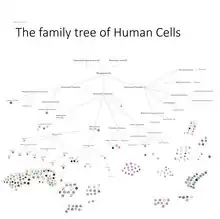 |
| Part of a series of lists about |
| Human anatomy |
|---|
There are about 30 trillion (3×1013) human cells in the adult human body, varying from about 20 to 40 trillion depending on the sex, age and weight, and a roughly equal number of bacterial cells.[1][2][3][4][5][6] The human cells have been categorized into over 400 cell types[2] based on location and function within the body, of which about 230 types are listed here.


 |
Cell type | % cell count |
| Erythrocytes (red blood cells) | 84.0 | |
| Platelets | 4.9 | |
| Bone marrow cells | 2.5 | |
| Vascular endothelial cells | 2.1 | |
| Lymphocytes | 1.5 | |
| Hepatocytes | 0.8 | |
| Neurons and glia | 0.6 | |
| Bronchial endothelial cells | 0.5 | |
| Epidermal cells | 0.5 | |
| Respiratory interstitial cells | 0.5 | |
| Adipocytes (fat cells) | 0.2 | |
| Dermal fibroblasts | 0.1 | |
| Muscle cells | 0.001 | |
| Other cells | 2.0 |
.png.webp)
There are many different types of cells in the human body.
Major efforts to map all human cells
Several efforts have been made to make a list or a map of all human cells.[8][9][10] One of the largest and most recent is the HuBMAP (Human BioMolecular Atlas Program).[11] They managed to organize 1551 samples across 17 collections. However, this project still only mapped about 31 of the human bodies' 70 organs. Their datasets and visualisations place great emphasis on biomarkers and location in the body, but less on cell development and how cells can change over time. Usually specific surface proteins are used to identify cells, and based on this they are put into different categories. Another major effort to make an overview of these proteins that allows us to observe cell types is the Swedish Protein Atlas.[12]
The Human Brain Project has attempted to map the human brain,[13][14] although much of the publicly accessible model does not have cellular resolution.
Complete lists of human cells known so far
Cells derived primarily from endoderm
The endodermal cells primarily generate the lining and glands of the digestive tube[15]
Cells derived primarily from ectoderm
Nervous system
There are nerve cells, also known as neurons, present in our human body. They are branched out. These cells make up nervous tissue. A neuron consists of a cell body with a nucleus and cytoplasm, from which long thin hair-like parts arise.
Central nervous system neurons and glial cells
(large variety of types, still poorly classified)
Cells derived primarily from mesoderm
Note: Cephalic connective tissue and bones are derived from the Cranial neural crest which comes from the ectoderm germ layer
List of databases relevant to this list
| Name | Provider | Sources of revenue/sponsers |
|---|---|---|
| HubMap[18] | A series of US based universities | Unknown |
See also
References
- ↑ Hatton IA, Galbraith ED, Merleau NS, Miettinen TP, Smith BM, Shander JA (September 2023). "The human cell count and size distribution". Proceedings of the National Academy of Sciences of the United States of America. 120 (39): e2303077120. doi:10.1073/pnas.2303077120. PMC 10523466. PMID 37722043.
- 1 2 "Mapping the human body one cell at a time: New study reveals the intricate relationship between cell size and count". News-Medical.net. 2023-09-19. Retrieved 2023-10-18.
- ↑ Society, Max Planck. "Cellular cartography: Charting the sizes and abundance of our body's cells reveals mathematical order underlying life". medicalxpress.com. Retrieved 2023-10-18.
- 1 2 Sender R, Fuchs S, Milo R (August 2016). "Revised Estimates for the Number of Human and Bacteria Cells in the Body". PLOS Biology. 14 (8): e1002533. doi:10.1371/journal.pbio.1002533. PMC 4991899. PMID 27541692.
- ↑ Hewings-Martin Y (12 July 2017). "How many cells are in the human body?". Medical News Today. Retrieved 28 June 2023.
- ↑ Zimmer C (23 October 2013). "How Many Cells Are In Your Body?". National Geographic. Archived from the original on April 3, 2021. Retrieved 29 June 2023.
- ↑ Hatton, Ian A.; Galbraith, Eric D.; Merleau, Nono S. C.; Miettinen, Teemu P.; Smith, Benjamin McDonald; Shander, Jeffery A. (2023-09-26). "The human cell count and size distribution". Proceedings of the National Academy of Sciences. 120 (39). doi:10.1073/pnas.2303077120. ISSN 0027-8424. PMC 10523466. PMID 37722043.
- ↑ "Home". humancellatlas.org. Retrieved 5 May 2023.
- ↑ "NIH to build a detailed map of cells within the human body". National Institutes of Health (NIH). 26 September 2018. Retrieved 5 May 2023.
- ↑ Davis D. "The ambitious quest to map every cell in our body". BBC. Retrieved 5 May 2023.
- ↑ "The HuBMAP Human BioMolecular Atlas Program". HuBMAP Consortium. Retrieved 5 May 2023.
- ↑ "The Human Protein Atlas". www.proteinatlas.org. Retrieved 19 July 2023.
- ↑ "Siibra Explorer". atlases.ebrains.eu. Retrieved 2023-07-02.
- ↑ "Medical Data Analytics". The Human Brain Project. Retrieved 2 July 2023.
- ↑ Gilbert SF (2000). "Endoderm". Developmental Biology (6th ed.). Sunderland (MA): Sinauer Associates. Retrieved 2023-07-02.
- ↑ "Brunner Gland - an overview | ScienceDirect Topics". www.sciencedirect.com. Retrieved 2023-12-10.
- ↑ "CCF ASCT+B Reporter". Hubmap Consortium.
- ↑ "The Human BioMolecular Atlas Program (HuBMAP)". commonfund.nih.gov. 5 January 2017. Retrieved 2023-07-12.